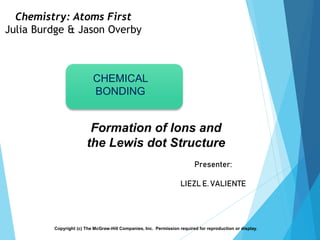
CHEMICAL BONDING.ppt
- 1. Chemistry: Atoms First Julia Burdge & Jason Overby Copyright (c) The McGraw-Hill Companies, Inc. Permission required for reproduction or display. CHEMICAL BONDING Formation of Ions and the Lewis dot Structure Presenter: LIEZL E. VALIENTE
- 2. 1. Explain the formation of ionic and covalent bonds 3. Illustrate lewis dot structure of the representative elements 4. Illustrate the chemical bonding of ionic and covalent bond using their lewis dot structure 2. Explain the formation of ions
- 4. Atoms combine in order to achieve a more stable electron configuration. Maximum stability results when a chemical species is isoelectronic with a noble gas. Na: 1s22s22p63s1 Na+: 1s22s22p6 10 electrons total, isoelectronic with Ne Cl: 1s22s22p63s23p5 Cl‒: 1s22s22p63s23p6 18 electrons total, isoelectronic with Ar
- 6. Chemical Bonding • refers to the formation of a chemical bond between two or more atoms, molecules, or ions to give rise to a chemical compound. Chemical Bonds -the attractive force that holds atom together.
- 7. The Lewis Theory -named after Gilbert Newton Lewis, a pioneer in understanding the relationship between Lewis structure and chemical bonding. 1. Valence electrons play a fundamental role in chemical bonding 2. Chemical bonding that results from the transfer of 1 or more electrons from 1 atom to another leading to the formation of positive and negative ions is called ionic 3. Chemical bonding that involves the sharing of electrons is called covalent (non-polar and polar) 4. Electrons are transferred/ shared to the extent that each atom acquires an especially stable electron configuration. Usually the configuration of a noble gas (8 outer shell electrons)
- 8. When atoms form compounds, it is their valence electrons that actually interact. A Lewis dot symbol consists of the element’s symbol surround by dots. Each dot represents a valence electron. Boron 1s22s22p1 3 valence electrons B • • • Lewis dot symbol for boron B • • • B • • • B • • • other reasonable Lewis dot symbols for boron Lewis Dot Symbols
- 9. Lewis Dot Symbols Lewis dot symbols of the representative group elements.
- 10. Write the Lewis dot Structure: 1. Cl 2. Na 3. Mg 4. Ca 5. K 6. Br 7. Sr 8. F 9. I 10. O
- 11. Types of Chemical Bonds Metal Non-Metal Ionic Bond
- 12. Ionic Bond bond forms when the valence (outermost) electrons of one atom are transferred permanently to another atom. The atom that loses the electrons becomes a positively charged ion (cation), while the one that gains them becomes a negatively charged ion (anion).
- 15. Lewis Dot Symbols Ions may also be represented by Lewis dot symbols. Na• Na 1s22s22p63s1 Na+ 1s22s22p6 Na+ O •• • • •• O 1s22s22p4 O2‒ 1s22s22p6 O •• •• • • • • 2‒ Core electrons not represented in the Lewis dot symbol Valence electron lost in the formation of the Na+ ion. Remember the charge
- 16. Write the Lewis symbols for each of the following ions: 1. As3– 2. I + 3. Be2+ 4. O2– 5. Ga3+
- 17. Illustrate the Lewis dot structure of the ionic compounds: 1. Magnesium + Oxygen 2. Calcium + Chlorine 3. Potassium + Flourine 4. Sodium + Bromine 5. Magnesium + Sulfur
- 18. Covalent Bond bond forms from non metal – non metal when atoms share one or more pairs of electrons. -happens when the difference between the electronegativities of the atom is not enough to an electron to transfer. The higher the electronegativity, the more desperate for an electron the atom is.
- 19. Polar and Nonpolar Covalent Bonds In the nonpolar covalent bond of H2, electrons are shared equally. In the polar covalent bond of HCl, electrons are shared unequally.
- 20. Two types of covalent bonds Nonpolar Covalent Bonds (equal share of electrons) often occurs in diatomic molecules such as Cl-Cl, N-N, O-O, F-F
- 21. Polar Covalent Bond • A Polar Covalent Bond is unequal sharing of electrons between two atoms.
- 22. Illustrate the Lewis dot structure of the covalent compounds: 1. Oxygen + Oxygen 2. Nitrogen- Nitrogen 3. Water (H2O) 4. Carbon dioxide (CO2) 5. Methane (CH4)
- 23. Metallic Bonding Metallic bonds occur between metals. result from the electrostatic attraction between metal cations and delocalized electrons. The nature of metallic bonding accounts for many of the physical properties of metals, such as conductivity and malleability.
- 25. Classification of Bonds You can determine the type of bond between two atoms by calculating the difference in electronegativity values between the elements The bigger the electronegativity difference the more polar the bond. Type of Bond Electronegativity Difference Nonpolar Covalent 0 0.4 Polar Covalent 0.5 1.9 Ionic 2.0 4.0
- 26. Electronegativity and Types of Bonds
- 27. Practice What type of bond is HCl? (H = 2.1, Cl = 3.1) Your Turn To Practice N(3.0) and H(2.1) H(2.1) and H(2.1) Ca(1.0) and Cl(3.0) Al(1.5) and Cl(3.0) Mg(1.2) and O(3.5) H(2.1) and F(4.0) Difference = 3.1 – 2.1 = 1.0 Therefore it is polar covalent bond.